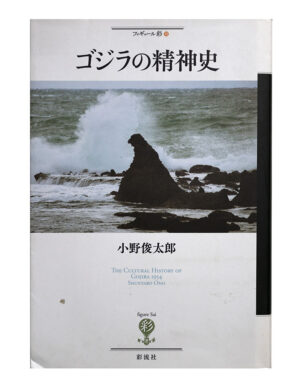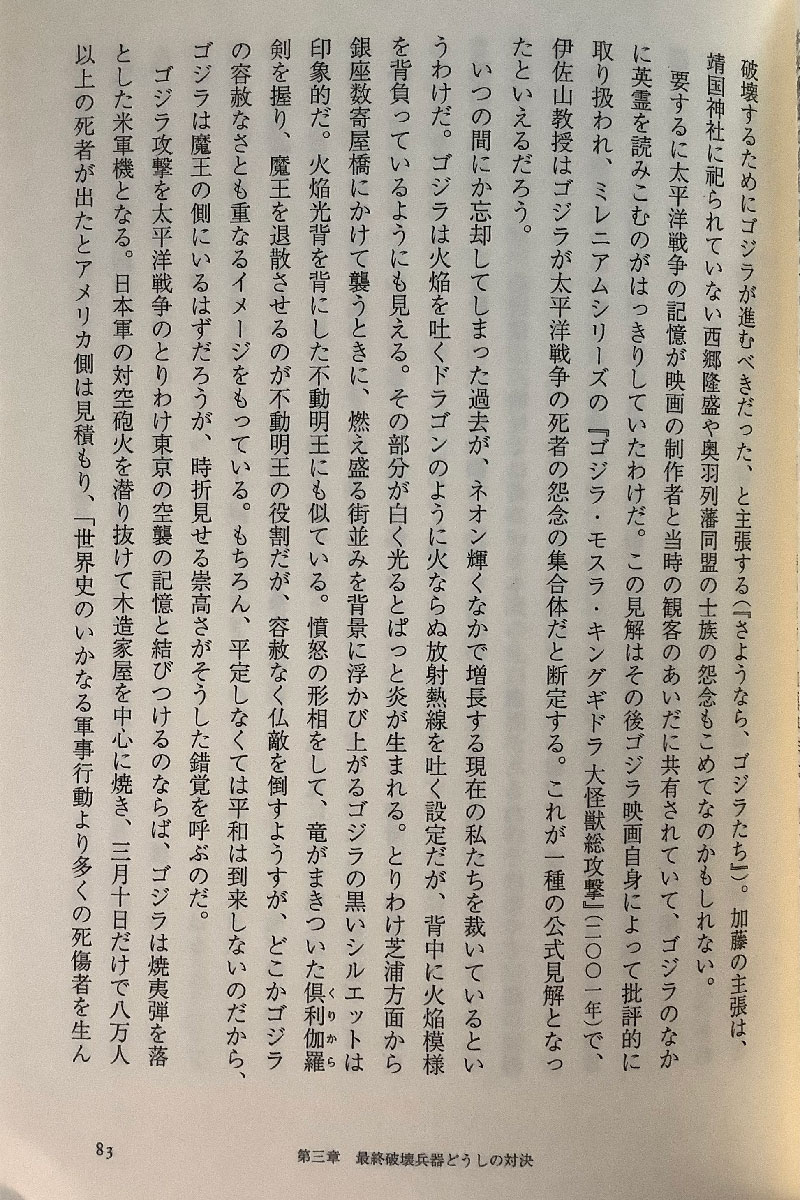3.14.2023
The Cultural History of Godzilla – Pt 33


P 82
江戸城から皇居へ
From Edo Castle to the Imperial Palace
こうして海から出現したゴジラは海へと還っていった。そのとき国会議事堂を壊すほど深く侵攻したゴジラが、遠く平河町のテレビ塔のあたりまで侵攻したのに、皇居の手前で向きを変えて、下町の勝鬨橋方面へと向かった。そこに何か深いメッセージが隠れていて、それが『ゴジラ』という作品のもつ魅力の源泉だという読みがなされてきた。
Godzilla emerged from the sea and returned to the sea. At that time, Godzilla, which had invaded so deeply that it destroyed the National Diet Building, invaded as far as the television tower in Hirakawacho, but turned around in front of the Imperial Palace and headed for Kachidoki Bridge in the downtown area. Some deep message is hidden there, and it has been read that it is the source of the charm of the work “Godzilla.”
この重要な指摘をしたのは川本三郎で、一連の復員兵が登場する映画を扱うなかで、『ゴジラ』を「海で死んでいった兵士たちへの「鎮魂歌」ととらえる。その上で、「天皇制の「暗い」呪縛力」のせいで「ゴジラはついに皇居だけは破壊できない」とする(「今ひとたびの戦後日本映画』)。そして、赤坂憲雄が皇居に住んでいるのが戦後の人間宣言をした天皇なので失望して帰ったとしたのを踏まえて、ゴジラが太平洋戦争の帰還兵士の亡霊という読みを示す加藤典洋は、もっと北にある靖国神社を破壊するためにゴジラが進むべきだった、と主張する(「さようなら、ゴジラたち』)。加藤の主張は、靖国神社に祀られていない西郷隆盛や奥羽列藩同盟の士族の怨念もこめてなのかもしれない。
This important point was made by Saburo Kawamoto, who regards “Godzilla” as “a ‘requiem’ for the soldiers who died at sea,” while dealing with a series of movies in which veterans appear. On top of that, he says, “Godzilla can’t destroy the Imperial Palace at last” because of “the ‘dark’ cursed power of the emperor system” (“A once-in-a-lifetime post-war Japanese movie”). And based on Norio Akasaka’s statement that he returned home in disappointment because the emperor who declared himself human after the war was living in the Imperial Palace, Norihiro Kato indicated that Godzilla was the ghost of a returning soldier from the Pacific War. Kato claims that Godzilla should have proceeded to destroy the Yasukuni Shrine in Tokyo (“Goodbye, Godzilla and the others”). It may be that I’m putting it together.

P 83
要するに太平洋戦争の記憶が映画の制作者と当時の観客のあいだに共有されていて、ゴジラのなかに英霊を読みこむのがはっきりしていたわけだ。この見解はその後ゴジラ映画自身によって批評的に取り扱われ、ミレニアムシリーズの「ゴジラ・モスラ・キングギドラ大怪獣総攻撃』(二〇〇一年)で、伊佐山教授はゴジラが太平洋戦争の死者の怨念の集合体だと断定する。これが一種の公式見解となったといえるだろう。
In short, the memories of the Pacific War were shared between the filmmakers and the audience at the time, and it was clear that the spirits of the heroes were read into Godzilla. This view was later treated critically by the Godzilla films themselves, and in the Millennium series Godzilla, Mothra, and King Ghidorah: Giant Monsters All-Out Attack (2001), Professor Isayama stated that Godzilla was a collection of grudges from the dead of the Pacific War. It can be said that this has become a kind of official view.
いつの間にか忘却してしまった過去が、ネオン輝くなかで増長する現在の私たちを裁いているというわけだ。ゴジラは火焔を吐くドラゴンのように火ならぬ放射熱線を吐く設定だが、背中に火焔模様を背負っているようにも見える。その部分が白く光るとぱっと炎が生まれる。とりわけ芝浦方面から銀座数寄屋橋にかけて襲うときに、燃え盛る街並みを背景に浮かび上がるゴジラの黒いシルエットは印象的だ。火焔光背を背にした不動明王にも似ている。憤怒の形相をして、竜がまきついた倶利伽羅くりから剣を握り、魔王を退散させるのが不動明王の役割だが、容赦なく仏敵を倒すようすが、どこかゴジラの容赦なさとも重なるイメージをもっている。もちろん、平定しなくては平和は到来しないのだから、ゴジラは魔王の側にいるはずだろうが、時折見せる崇高さがそうした錯覚を呼ぶのだ。
The forgotten past is judging us, who are growing in the glowing neon lights of the present. Godzilla is set to spew radiant heat rays rather than fire like a dragon spewing flames, but it also looks like he is carrying a flame pattern on his back. When that part glows white, a flame is born. Especially when attacking from Shibaura to Ginza Sukiyabashi, Godzilla’s black silhouette that emerges against the background of the burning cityscape is impressive. It resembles Fudo Myo-o with a flame halo behind it. Fudo Myoo’s role is to make a face of wrath, grasp the sword from Kurikara-kuri wrapped in a dragon, and drive away the demon king. Of course, peace will not come without pacification, so Godzilla should be on the demon king’s side, but the sublime he sometimes shows creates such an illusion.
Fudo Myo-o. Fudo Myo-o, in Japanese Buddhist mythology, the fierce form of the Buddha Vairocana, and the most important of the Myō-ō class of deities. (Source: Britannica.com https://www.britannica.com/topic/Fudo-Myo-o)
Kurikara (also written as Kurikara) is the name of a dragon (dragon king) that is said to be an incarnation of Fudo Myoo derived from Sanskrit “kulihah.” It is depicted as a black dragon entwined with a sword (Kurikara sword). Kurikara Dragon King. (Source: Wikipedia https://ja.wikipedia.org/wiki/倶利伽羅)
ゴジラ攻撃を太平洋戦争のとりわけ東京の空襲の記憶と結びつけるのならば、ゴジラは焼夷弾を落とした米軍機となる。日本軍の対空砲火を潜り抜けて木造家屋を中心に焼き、三月十日だけで八万人以上の死者が出たとアメリカ側は見積もり、「世界史のいかなる軍事行動より多くの死傷者を生ん「だ」と自画自賛したほどだった(ロナルド・シェイファー『アメリカの日本空襲にモラルはあったか』)。
If we associate Godzilla’s attack with memories of the Pacific War, especially the air raids on Tokyo, then Godzilla is the American plane that dropped the incendiary bomb. The U.S. estimated that more than 80,000 people died on March 10 alone as they escaped Japanese anti-aircraft fire and burned mainly wooden houses. He even praised himself, saying, “No,” (Ronald Shaffer, “Was there morals in America’s air raids on Japan?”).

P 84
それは原爆に匹敵するほどの焦土を生み出したが、一部が焼けた皇居も国会議事堂も生き延びた。そして、戦後の日本の司令塔は国会議事堂である。それを完膚なきまでに壊したのだから、あらためてゴジラが皇居を壊す必要はなかったはずだ。言うまでもなく、二者択一なのではなくて「ゴジラ=英霊」と同時に「ゴジラ=アメリカ」という要素がゴジラの動きに関係している。
It produced as much scorched earth as an atomic bomb, but the partially burned Imperial Palace and the Diet building survived. After the war, Japan’s control tower was the Diet Building. Godzilla didn’t need to destroy the Imperial Palace again because he completely destroyed it. Needless to say, the elements of “Godzilla = Heroic Spirit” and “Godzilla = America” are related to Godzilla’s movement, rather than choosing between the two.
『ゴジラ』をさらに古層ともいえる黒船や日米和親条約と結びつけると、ゴジラが近づけなかった皇居がもとは江戸城だった点が重要となる。現在公園となっている北の丸には代官屋敷がおかれていたし、皇居東御苑は江戸城の本丸、二の丸、三の丸にあたる。だからこそ、私たちは松の廊下や天守の跡を見ることができるのだ。じつは天皇の居住地である吹上御所のある場所は、御三家のための西の丸であり、一六五七年の明暦の大火(いわゆる振袖火事)で屋敷が焼けて、その後に火除け地となっ明治まで自然のまま放置されていた。都内で希少な動植物が生息しているのもそのおかげである。形式の上から言えば、皇居は江戸城址ではあるが、本丸の上に御所があるわけではなくて、江戸城の遺構と並存しているのだ。ゴジラの侵攻を江戸城の防衛線であったお堀が守ってくれたことになる。
If you connect “Godzilla” with the black ships and the Japan-U.S. Treaty of Peace and Amity, which can be said to be even older, it becomes important that the Imperial Palace, which Godzilla could not approach, was originally Edo Castle. The Kitanomaru, which is now a park, was home to the magistrate’s residence, and the East Gardens of the Imperial Palace correspond to the Honmaru, Ninomaru, and Sannomaru of Edo Castle. That’s why we can see the pine corridor and the ruins of the keep. In fact, the place where the Emperor’s residence, Fukiage Gosho, is located is the Nishinomaru for the Gosanke. It was left in its natural state until the Meiji era. It is thanks to this that rare animals and plants live in Tokyo. Formally speaking, the Imperial Palace is the ruins of Edo Castle, but the Imperial Palace is not located above the Honmaru, and it coexists with the remains of Edo Castle. The moat, which was the defense line of Edo Castle, protected the invasion of Godzilla.
江戸時代や幕末の出来事という通奏低音が、まさにゴジラの足音のように響いている。考えてみると、古い天守閣)が現存する松本城や姫路城とか、近代的に再建された大阪城や名古屋城と異なって、江戸城の天守を私たちは頭に思い浮かべられない。それは明暦の大火によって江戸が焼失したときに天守も焼け落ちたせいだ。復興を優先するとして、建築予算が獲得できずに再建されなかった。それに「江戸の平和」を象徴するように、もはや江戸城は戦闘用の城郭の役目を終えたので天守は不要とみなされたのだ。この江戸城が明治維新で「宮城」となり、戦後には「皇居」となっていくのだが、そこに引き継がれたのは戦闘用の城というイメージではない。江戸城はむしろ幕藩体制維持のための政治をおこなう場であり、大奥のように将軍の世継ぎを生み出す場であった。
The continuo of events in the Edo period and the end of the Tokugawa shogunate echoes like Godzilla’s footsteps. Come to think of it, unlike Matsumoto Castle and Himeji Castle, which still have old castle towers, or the modern reconstructions of Osaka Castle and Nagoya Castle, we can’t imagine the keep of Edo Castle. This is because the castle tower was burned down when Edo was destroyed by the Great Fire of Meireki. It was not rebuilt because the construction budget could not be obtained because reconstruction was given priority. Moreover, as if to symbolize the peace of Edo, Edo Castle no longer served as a castle for battle, so the castle tower was deemed unnecessary. During the Meiji Restoration, this Edo Castle became the “Miyagi” and after the war it became the “Imperial Palace,” but the image of the castle as a battlefield was not inherited. Rather, Edo Castle was a place to carry out politics to maintain the shogunate system and, like Ooku, a place to produce successors to the shogunate.
continuo – noun: continuo; plural noun: continuos; noun: basso continuo; plural noun: basso continuos (in baroque music) an accompanying part that includes a bassline and harmonies, typically played on a keyboard instrument and with other instruments such as cello or lute.

P 85
ゴジラが東京湾岸の地区を襲った様子を江戸城址である皇居の側から眺めたならば、炎の大パノラマが南から東に広がるのが見えたはずだ。私たちは攻めこむゴジラに感情移入してしまい、そこから議論を進めがちである。だが、皇居=江戸城を守る防衛線は江戸時代から築かれていたのであり、台場も含めて幕末の防衛の仕掛けがゴジラの侵攻を最小限に食い止めた。それにその前から空襲は皇居はるか飛び越えて、もっと内陸の飛行場を攻撃していた(こちらの記憶を想像的に描いたのが『モスラ』だったわけだ)。
If you watched Godzilla attack the Tokyo Bay area from the side of the Imperial Palace, the ruins of Edo Castle, you would have seen a vast panorama of flames spreading from south to east. We tend to empathize with the invading Godzilla and proceed from there. However, the defensive line protecting the Imperial Palace = Edo Castle had been built since the Edo period, and the defense mechanism at the end of the Edo period, including Daiba, minimized Godzilla’s invasion. And even before that, the air raids had jumped far beyond the Imperial Palace and attacked airfields further inland (Mothra was an imaginative depiction of this memory).
幕末に江戸城そのものが焼け落ちる可能性もあった。江戸城をめぐる争いとして記憶されるのは、黒船の大砲による攻撃の脅威よりも、明治維新のなかで品川から上野の方面へと駆け抜けていった新政府軍の動きだろう。これがゴジラの動きと重なってくるようにも思える。江戸城が一八六八年五月に無血開城したことで、幕府側の陥落は確定的になった。江戸城を猛攻すると考えていた新政府軍が譲歩した背後には、戦争の混乱で貿易などで損をするのではないかというイギリスの思惑や外圧があったとされる。
There was also the possibility that Edo Castle itself would burn down at the end of the Edo period. Rather than the threat of an attack from the Black Ships’ cannons, what is remembered as the battle over Edo Castle is probably the movement of the new government forces rushing from Shinagawa to Ueno during the Meiji Restoration. It seems that this overlaps with the movement of Godzilla. With the bloodless surrender of Edo Castle in May 1868, the fall of the shogunate became a certainty. It is said that behind the concessions of the new government’s army, which had been thinking of making a fierce attack on Edo Castle, there was British speculation and external pressure that they might lose money in trade due to the turmoil of the war.
だが戊辰戦争は続き、七月の「上野戦争」で彰義隊が立てこもった寛永寺の大半が新政府軍の砲弾攻撃などで焼け落ちた。焼け落ちたのは、明暦の大火や安政の大地震に比べれば狭い範囲だが、天災や火事ではなくて戦争によって意図的に破壊された場所として意味がある。「尊皇攘夷」から「尊皇開国」へと転換した倒幕の動きこそが日本の近代化を後押ししてきたのだ。
However, the Boshin War continued, and most of Kan’ei-ji Temple, where the Shogitai had barricaded themselves in the “Ueno War” in July, was burned down by artillery attacks by the new government forces. Compared to the Great Fire of Meireki and the Great Ansei Earthquake, the area that burned down was small, but it is meaningful as a place that was intentionally destroyed by war, not by natural disasters or fires. The movement to overthrow the shogunate, which shifted from ‘respect the emperor and expel the barbarians’ to ‘respect the emperor and open the country,’ has been the driving force behind Japan’s modernization.
The Boshin War, sometimes known as the Japanese Revolution or Japanese Civil War, was a civil war in Japan fought from 1868 to 1869 between forces of the ruling Tokugawa shogunate and a clique seeking to seize political power in the name of the Imperial Court. (Source: Wikipedia)

P 86
その富国強兵の結果とし東京大空襲に始まる名古屋、大阪、神戸といった大都市を狙う空襲があった。
As a result of the rich country strong army, there were air raids aimed at big cities such as Nagoya, Osaka, and Kobe, starting with the Tokyo air raid.